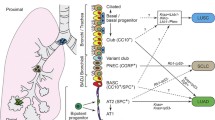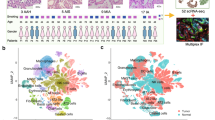Abstract
The clinicopathological differences among high-grade fetal lung adenocarcinomas completely comprising tumor cells that resemble fetal lung epithelium (pure type) and those with fetal lung-like components admixed with conventional adenocarcinoma cells (mixed type) remain undetermined. Here, we examined the clinicopathological, immunohistochemical, and molecular features of 11 lung adenocarcinomas with fetal lung-like morphology among 3895 consecutive cases of primary lung cancer based on the expression pattern of transcription factors. According to the current WHO classification, two cases (0.05%) were categorized as low-grade fetal adenocarcinoma, two cases (0.05%) were pure-type high-grade fetal adenocarcinoma, five cases (0.1%) were mixed-type high-grade fetal adenocarcinoma, and the remaining two cases (0.05%) were lung adenocarcinoma with high-grade fetal features (fetal lung-like morphology occupied less than 50%). CTNNB1 mutations were exclusively identified in low-grade fetal adenocarcinomas. In contrast, mixed-type high-grade fetal adenocarcinoma or lung adenocarcinoma with high-grade fetal features frequently harbored mitogenic drivers including EGFR mutations. Furthermore, almost all tumor cells expressed CDX2 and HNF4α in both cases of pure-type high-grade fetal lung adenocarcinoma, but lacked TTF-1 positivity. In contrast, TTF-1 was frequently expressed in mixed-type high-grade fetal lung adenocarcinoma and in lung adenocarcinoma with high-grade fetal features. Our data suggest similar prevalence of low-grade fetal lung adenocarcinoma and pure-type high-grade fetal lung adenocarcinoma, and indicate that pure- and mixed-type high-grade fetal lung adenocarcinomas are distinct, with the former akin to low-grade fetal adenocarcinoma with respect to purely embryonic morphology and absence of common lung adenocarcinoma mitogenic drivers, and the latter being genetically and transcriptionally related to conventional lung adenocarcinoma.




Similar content being viewed by others
References
WHO classification of Tumours Editorial Bord (2021) Thoracic tumors. Int Agency Res Cancer 5:81–82
Ricaurte LM, Arrieta O, Zatarain-Barron ZL et al (2018) Comprehensive review of fetal adenocarcinoma of the lung. Lung Cancer (Auckl) 9:57–63
Nakatani Y, Kitamura H, Inayama Y et al (1998) Pulmonary adenocarcinomas of the fetal lung type: a clinicopathologic study indicating differences in histology, epidemiology, and natural history of low-grade and high-grade forms. Am J Surg Pathol 22:399–411
Schittny JC (2017) Development of the lung. Cell Tissue Res 367:427–444
Nakatani Y, Masudo K, Miyagi Y et al (2002) Aberrant nuclear localization and gene mutation of beta-catenin in low-grade adenocarcinoma of fetal lung type: up-regulation of the Wnt signaling pathway may be a common denominator for the development of tumors that form morules. Mod Pathol 15:617–624
Morita S, Yoshida A, Goto A et al (2013) High-grade lung adenocarcinoma with fetal lung-like morphology: clinicopathologic, immunohistochemical, and molecular analyses of 17 cases. Am J Surg Pathol 37:924–932
Suzuki M, Yazawa T, Ota S et al (2015) High-grade fetal adenocarcinoma of the lung is a tumour with a fetal phenotype that shows diverse differentiation, including high-grade neuroendocrine carcinoma: a clinicopathological, immunohistochemical and mutational study of 20 cases. Histopathology 67:806–816
Nowick K, Stubbs L (2010) Lineage-specific transcription factors and the evolution of gene regulatory networks. Brief Funct Genomics 9:65–78
Suzuki M, Kasajima R, Yokose T et al (2021) Comprehensive molecular analysis of genomic profiles and PD-L1 expression in lung adenocarcinoma with a high-grade fetal adenocarcinoma component. Transl Lung Cancer Res 10:1292–1304
Li Y, Xi SY, Yong JJ et al (2021) Morphologic, immunohistochemical, and genetic differences between high-grade and low-grade fetal adenocarcinomas of the lung. Am J Surg Pathol 45:1464–1475
Chen Y, Xu L, Lin RY et al (2020) Core transcriptional regulatory circuitries in cancer. Oncogene 39:6633–6646
Yatabe Y, Mitsudomi T, Takahashi T (2002) TTF-1 expression in pulmonary adenocarcinomas. Am J Surg Pathol 26:767–773
Baine MK, Hsieh MS, Lai WV et al (2020) SCLC subtypes defined by ASCL1, NEUROD1, POU2F3, and YAP1: a comprehensive immunohistochemical and histopathologic characterization. J Thorac Oncol 15:1823–1835
Gay CM, Stewart CA, Park EM et al (2021) Patterns of transcription factor programs and immune pathway activation define four major subtypes of SCLC with distinct therapeutic vulnerabilities. Cancer Cell 39:346–360 e347
Kishikawa S, Hayashi T, Saito T et al (2021) Diffuse expression of MUC6 defines a distinct clinicopathological subset of pulmonary invasive mucinous adenocarcinoma. Mod Pathol 34:786–797
Hara K, Saito T, Hayashi T et al (2015) A mutation spectrum that includes GNAS, KRAS and TP53 may be shared by mucinous neoplasms of the appendix. Pathol Res Pract 211:657–664
Hara K, Saito T, Hayashi T et al (2017) Inverse correlation between galectin-4 and TTF-1 in lung adenocarcinoma. Virchows Arch 471:375–382
Suehara Y, Arcila M, Wang L et al (2012) Identification of KIF5B-RET and GOPC-ROS1 fusions in lung adenocarcinomas through a comprehensive mRNA-based screen for tyrosine kinase fusions. Clin Cancer Res 18:6599–6608
Hayashi T, Takamochi K, Yanai Y et al (2018) Non-small cell lung carcinoma with diffuse coexpression of thyroid transcription factor-1 and DeltaNp63/p40. Hum Pathol 78:177–181
Kurihara T, Suehara Y, Akaike K et al (2020) Nanostring-based screening for tyrosine kinase fusions in inflammatory myofibroblastic tumors. Sci Rep 10:18724
Boland CR, Thibodeau SN, Hamilton SR et al (1998) A National Cancer Institute Workshop on Microsatellite Instability for cancer detection and familial predisposition: development of international criteria for the determination of microsatellite instability in colorectal cancer. Cancer Res 58:5248–5257
Jordan EJ, Kim HR, Arcila ME et al (2017) Prospective comprehensive molecular characterization of lung adenocarcinomas for efficient patient matching to approved and emerging therapies. Cancer Discov 7:596–609
Huels DJ, Ridgway RA, Radulescu S et al (2015) E-cadherin can limit the transforming properties of activating β-catenin mutations. EMBO J 34:2321–2333
Tanaka H, Yanagisawa K, Shinjo K et al (2007) Lineage-specific dependency of lung adenocarcinomas on the lung development regulator TTF-1. Cancer Res 67:6007–6011
Gao N, White P, Kaestner KH (2009) Establishment of intestinal identity and epithelial-mesenchymal signaling by Cdx2. Dev Cell 16:588–599
Silberg DG, Sullivan J, Kang E et al (2002) Cdx2 ectopic expression induces gastric intestinal metaplasia in transgenic mice. Gastroenterology 122:689–696
Stringer EJ, Duluc I, Saandi T et al (2012) Cdx2 determines the fate of postnatal intestinal endoderm. Development 139:465–474
Verzi MP, Shin H, San Roman AK et al (2013) Intestinal master transcription factor CDX2 controls chromatin access for partner transcription factor binding. Mol Cell Biol 33:281–292
Sonzogni A, Bianchi F, Fabbri A et al (2017) Pulmonary adenocarcinoma with mucin production modulates phenotype according to common genetic traits: a reappraisal of mucinous adenocarcinoma and colloid adenocarcinoma. J Pathol Clin Res 3:139–152
WHO classification of Tumours Editorial Bord (2019) Digestive system tumours. Int Agency Res Cancer 5:91–92
Yamaguchi T, Hosono Y, Yanagisawa K, Takahashi T (2013) NKX2-1/TTF-1: an enigmatic oncogene that functions as a double-edged sword for cancer cell survival and progression. Cancer Cell 23:718–723
Yamaguchi YL, Tanaka SS, Kumagai M et al (2015) Sall4 is essential for mouse primordial germ cell specification by suppressing somatic cell program genes. Stem Cells 33:289–300
Acknowledgements
This work was performed in part at the Intractable Disease Research Center, Juntendo University.
Funding
This work was supported in part by a Grant-in-Aid from the Japan Society for the Promotion of Science (JSPS) KAKENHI (grant number 19K07469) and Practical Research for Innovative Cancer Control (grant number JP18ck0106252) from the Japan Agency for Medical Research and Development (AMED). This work was also supported in part by the Takeda Science Foundation.
Author information
Authors and Affiliations
Contributions
Satsuki Kishikawa, Takuo Hayashi, Tsuyoshi Saito, Noriko Sasahara, and Takashi Yao provided histopathological and immunohistochemical information. Kazuya Takamochi and Kenji Suzuki provided patients’ clinical information. Satsuki Kishikawa, Takuo Hayashi, Tsuyoshi Saito, Kazuya Takamochi, Keita Sasa, Yoshiyuki Suehara, Fumiyuki Takahashi, and Shinji Kohsaka conceived molecular experiments and analyzed data. All authors were involved in writing the paper and had final approval of the submitted and published versions. Takuo Hayashi takes full responsibility for the work as a whole, including the study design, access to data, and the decision to submit and publish the manuscript.
Corresponding author
Ethics declarations
Ethics approval
The information contained in, and preparation of, this manuscript comply with the journal’s ethical standards. The study design was approved by the Institutional Review Board of Juntendo University (no. 2020264).
Conflict of interest
The authors declare no competing interests.
Additional information
Publisher’s note
Springer Nature remains neutral with regard to jurisdictional claims in published maps and institutional affiliations.
Supplementary information
Supplemental Fig. 1.
Hematoxylin-eosin staining of lung adenocarcinomas resembling the fetal lung (PDF 4752 kb). All cases exhibited at least one focal area resembling fetal lung epithelium.
Supplemental Fig. 2.
Representative immunohistochemical findings for SMARCA4 and SMARCB1. Tumor cell showed nuclear expression of SMARCA4 (case 4) and SMARCB1 (case 3) expression. (PDF 8924 kb)
Supplemental Fig. 3.
EGFR and CTNNB1 mutations in a case of mixed-type high-grade fetal lung adenocarcinoma. A. Genomic DNA was extracted from non-fetal and fetal lung-like components. EGFR and CTNNB1 mutations were detected in both components. B. Tumor cells in non-fetal and fetal lung-like components showed focal nuclear staining in lung adenocarcinoma with mixed fetal lung-like elements harboring CTNNB1 mutations. Note that tumor cells exhibited strong membranous expression of E-cadherin in both non-fetal and fetal lung-like components. (PDF 17933 kb)
ESM 4
(PDF 31 kb)
ESM 5
(XLSX 11 kb)
Rights and permissions
About this article
Cite this article
Kishikawa, S., Hayashi, T., Saito, T. et al. Distinct properties of pure- and mixed-type high-grade fetal lung adenocarcinomas by genetic profiling and transcription factor expression. Virchows Arch 480, 609–619 (2022). https://doi.org/10.1007/s00428-021-03247-7
Received:
Revised:
Accepted:
Published:
Issue Date:
DOI: https://doi.org/10.1007/s00428-021-03247-7




